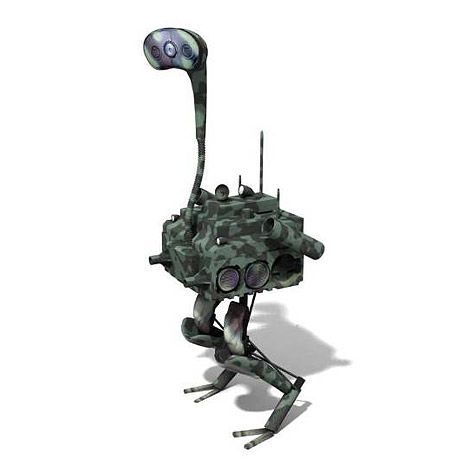Engineerblogger
Nov 15, 2011
I'll bet you didn't know that DARPA was even interested in a robotic ostrich, did you? I sure as heck didn't. But I suppose it shouldn't be that surprising, since DARPA seems to want robotic versions of just about anything that's capable of extreme levels of performance, and an ostrich apparently fits the, uh, bill.
The above image is a rendering of the eventual form of a robot called FastRunner, a project led by the Florida Institute for Human and Machine Cognition (IHMC), in Pensacola. MIT's Robot Locomotion Group is a partner in the project. FastRunner uses a novel* leg design that should allow it to efficiently sprint at speeds of over 30 kilometers per hour while stabilizing itself and only using one actuator per leg. It'll also be able to run over moderately rough terrain, albeit at 15 km/h, which is still probably going to give even a talented human a run for their money. To put the speed of this robot in perspective, a human can sprint at about 40 km/h over short, level distances, while an actual ostrich can hit almost 100 km/h, with sustained speeds in the 70s.
So far, FastRunner consists of legs and body in simulation, plus one full-scale test leg. When completed, the robot will weigh about 30 kilograms, stand 1.4 meters high, and offer fast, efficient, and very robust motion for whatever potentially sinister applications DARPA can dream up:
IHMC has a lot of experience building legged robots. Researchers there have focused on "biologically inspired hardware design, bipedal and quadrupedal walking, balance, and push-recovery control," among other things. They've written locomotion algorithms for the LittleDog program, another DARPA initiative, and they're also developing humanoid robots for operation in urban environments and robotic exoskeletons to assist people with limited mobility.
MIT, for their part, has a whole bunch of experience with making clever robots with legs. In fact, they have (or had, at any rate) a whole lab dedicated to it. Fans of cool robots might remember this Thanksgiving-themed post from 2008, showing a robotic turkey, chicken, and dinosaur walking around MIT back in 2001. Ostriches are functionally very similar to dinosaurs and their descendants (I'm talking about birds, of course), perhaps even more so since the noble ostrich doesn't rely on its wings for much more than providing shade for smaller ostriches.
Anyway, getting back to FastRunner, it's pretty clear that these researchers have a solid foundation for the design of this robot, especially if you think about where they were 10 years ago and all the technological wonderment that's happened between then and now. My only remaining question is this: Those tubes on the sides of the robot in the rendering... Rocket launchers, or turbojets?
Source: Spectrum IEEE

0 comments:
Post a Comment